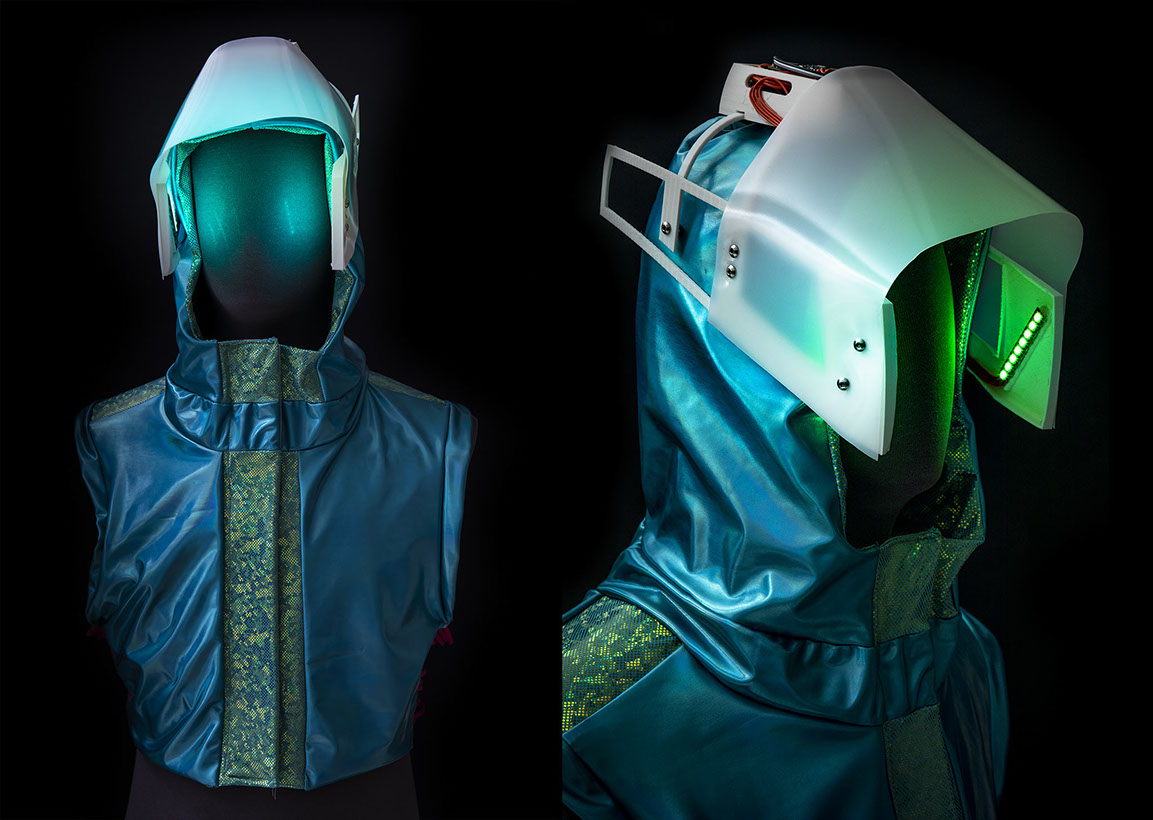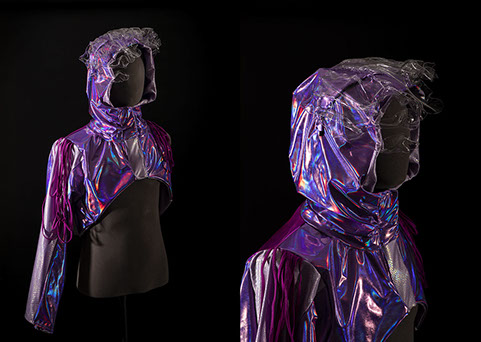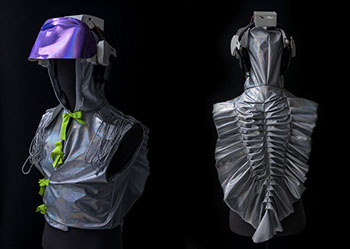PROGRAMMED SYMBIOSIS



CREDITS
This artwork was developed with the support of BBVA Foundation and Museo de Arte Carrillo Gil. Circuit design and development Hugo Vargas / Textile design Marie Paredes Arteaga (Kaleidoscopio brand) / Sound Eddie Castañeda
Programmed Symbiosis: post-Internet body consists of three wearables connected to social networks that modify the user’s perception while visiting an exhibition or space through stimuli caused by electronic devices. The pieces are the product of speculative design formulated by reflections on how technology can manipulate the body and how we accept its use without questioning, largely due to the ideas that popular (post-humanist) culture has implanted in the collective unconscious.
At the gallery, visitors can choose to wear one of the costumes and experience the rest of the exhibition with them. To do so, they must first read and sign a user agreement specifying the possible effects and responsibilities. They are also given quick instructions for interacting with the artwork. As a complement, users can also access a story that explains the origin of the pieces / prototypes from a dystopian present, in which the hype for using filters, applications and ‘free’ services ends with giving up the protagonist’s identity and body control to the corporations that initially offered health technology.
Link to Story 'A day tomorrow' (Spanish)
We accept the almost invisible surveillance of which we are a part by closing our eyes and admitting that there is nothing to hide anyway, most of us are not celebrities or criminals. So statistics applied to machine learning continue to calculate the correct answers and guide important decision making whose consequences we barely glimpse. Perhaps the body is the last bastion that resists being online, but not for long. New medical technologies promote implants and prosthetics that make efficient decisions about how their host’s body works. This project aims to take a small leap into the future and imagine how the control exercised over the bodies will be increasingly explicit, but sweetened with the offer to provide different extra-daily physical experiences, in the case of these prototypes, while watching the artwork of other artists in the gallery. The resulting suits mix Internet Of Things, social networks, engines, light and sound that affect the wearer’s perception from a post-internet aesthetic (a future seen in fiction decades ago that passed 2020 without fulfilling).


In the gallery three interactive suits are available for the audience:
Involuntary choreography (pink wearable). The popular filters for Instagram and FaceApp express, from my point of view, the need to recognize oneself and create a fantasy about it. Of course, they would be irrelevant if it weren’t for the number of individuals who see the results and like them. The risk some people are willing to take to have more followers on social networks has been demonstrated by those who have lost their lives trying to take the best selfie. Like a puppet, this piece manipulates the user’s right arm every time someone writes the hashtag #symbiosis in Twitter. The greater the number of people who tweet about the project in real time, the more manipulation (and ‘dance’) the user will undergo.


Induced emotion (blue wearable). The likes or ❤️ we give and receive on social networks are a form of validation, or at least allow us to see how many people see and enjoy what we do, however irrelevant it may be. This artwork tries to induce different moods in users, through the measurement of their heartbeats and colored lights. Then the wearable, when approaching the other artworks in the exhibition, reacts depending on the popularity of their authors on social networks.
280 Limit (silver wearable). Just as on Twitter or pedometers, there is a specific count of characters or steps to take, this wearable has a restriction for the user of 280 steps (or 140 if the space is smaller). User must then make a pause for 20 seconds or ‘pay the premium account’ before continuing, otherwise the suit covers her vision and produces sounds that try to confuse spatiality and sense of balance, preventing the user from walking. The user can count how many steps she has made through a small display on the suit’s sleeve.











